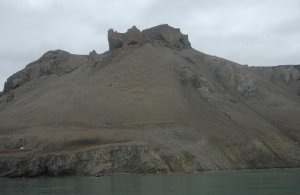Sorry, I cannot resist a good pun :)
In the first blog post in the series on Svalbard, I wrote that the holes in the limestone, up in the mountainside in the image below, were karst caves: Caves that form when fresh water from above circulate underground and slowly dissolves the carbonate.
Well… My friend and former colleague, Terje Solbakk, has pointed out that they are not really caves – the holes do not go very far into the wall. And he should know, because he has been crazy enough to walk up and look. And he has a MSc on limestone caves. Peer-review be damned!
More likely, the holes formed as much more recent tafoni – in a process quite similar to frost weathering, but by salt: We are in a fjord, and salt from the air clings to the rocks as a thin film, which then enters fractures, expands and breaks off pieces of rock.
According to Mr-working-to-become-Dr Solbakk, there are real karst on Svalbard as well, on the Blomstrand peninsula. And the story behind the holes in Billefjorden may also be a bit more complex than tafoni alone: The underlying anhydrite and gypsum may have been washed by ground water (just like the cave in Kungur in Russia), and the stiff limestone partly collapsed into the hole. Geologists don’t entirely agree on what and how happened. Because having various opinions are what geologists do, and because the geology often isn’t straightforward either.
But at least, now you know.
